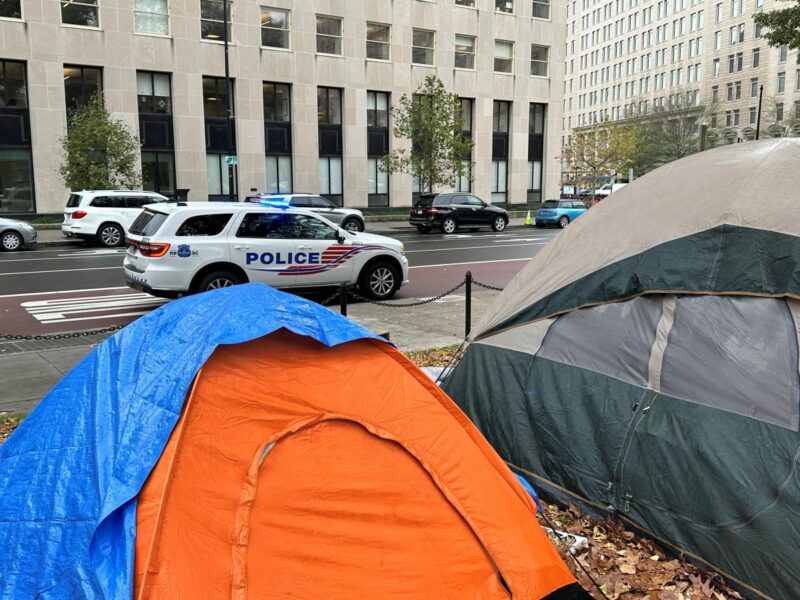A group that wants to expand California’s statewide ban on rent control says it has enough signatures to put it on the 2024 ballot. But the effort still faces an uphill climb as some lawmakers and special interest groups line up in opposition.
The Los Angeles-based AIDS Healthcare Foundation held a campaign launch on May 25, when the group introduced the ballot initiative, also known as the Justice for Renters Act. It seeks to allow local governments to pass ordinances to stabilize rents and address unaffordable housing, which AHF says on its website is “one of the root causes of homelessness.”
The initiative has gained the support of civil rights organizers and tenants across the state who argue that it will help farmworkers and low-income earning families stay in their homes as rents and rates of homelessness continue to climb. However, groups like the California Apartment Association have described the bill as “anti-housing” and say it could hinder the development of more affordable homes.
“Everyone knows that housing affordability and homelessness are the number one issues in California,” AHF president Michael Weinstein said at the rally. “So why does nothing get done? Because money talks.”
Limits on Rent Control Policies
Since 1995, California has had a law on its books known as the Costa-Hawkins Act that limits the ability of local governments to install rent control policies. The law says landlords may only increase rents the lower of either 5% plus inflation or 10% per year. It also only applies to buildings built after 1995, the year the law was signed.
The Justice for Renters Act, or Senate Bill 466, would undo this system by creating two rolling dates for eligibility—one that applies to new buildings built before 1995 and those built after that date. The legislation would essentially strip buildings of their rent control exemption as soon as they turn 28 years old to match the age of the Costa-Hawkins bill.
Even though the initiative has not been officially drafted yet, special interest groups have already lined up in opposition.
Mike Nemeth, the communications director for the California Apartment Association, wrote that SB 466 would “undoubtedly create confusion and uncertainty for housing providers across the state” and could potentially depress development as “California struggles to increase and maintain its meager inventory of housing.”
“Essentially, this legislation says that California would prefer to solve its housing crisis through regulations vs. investment in building the millions of homes needed to address California’s housing shortage,” Nemeth wrote.
Similarly, the California Rental Housing Association called on its members to oppose SB 466. The organization argued in a study that ending California’s Costa-Hawkins law would worsen the state’s affordability crisis and prevent hundreds of thousands of new homes from being built.
“Rent control deters investment and development in part because it limits the ability to keep pace with operational costs and generate revenue while also signaling a higher risk of future policy restrictions,” the study reads in part.
The efforts to expand California’s rent control laws come as the state grapples with a sizable increase in homelessness.
According to the latest federal one-night count, more than 172,000 people are experiencing homelessness in California, representing about 30% of the nationwide total. That population also increased by more than 6% year-over-year, with families with children and those experiencing unsheltered homelessness seeing the most significant increases.
Some firms like global consultancy McKinsey & Company have suggested that California lawmakers begin taking a hyper-local approach to solving these issues instead of painting with a broad brush.
In March, McKinsey released a paper that outlined several steps officials in Los Angeles could take to reduce the city’s swelling rate of homelessness. One solution the paper mentions is to create tailored support services like rapid rehousing programs to help address the needs of people experiencing different kinds of homelessness.
It also suggests that officials create programs that help ease the rent burden for many low-income families. One solution is to connect people at risk of experiencing homelessness with programs like CalFresh, the state’s food benefits program, and the Women, Infants, and Children program that could “free up money normally spent on food or rent or other necessities,” according to the paper.
How You Can Help
The pandemic proved that we need to rethink housing in the United States. It also showed that aid programs work when providing agencies and service organizations with sufficient funds and clear guidance on spending aid dollars.
Tell your representatives you support revamping how your city addresses homelessness. We must focus on compassionate solutions, the first step to ending homelessness.













